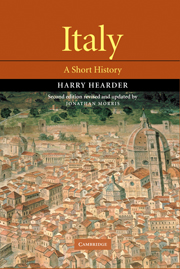Book contents
- Frontmatter
- Contents
- List of illustrations
- Preface
- 1 Italy in the classical world
- 2 The early Middle Ages
- 3 The high Middle Ages
- 4 The Renaissance
- 5 The political and cultural eclipse of Italy
- 6 The Risorgimento, 1790–1861
- 7 From Unification to Fascism, 1861–1922
- 8 The Fascist disaster, 1922–45
- 9 Italy since the Second World War, 1945–80
- Epilogue: From the First to the Second Republic: Italy 1980–2001
- A brief guide to further reading
- Index
Preface
Published online by Cambridge University Press: 05 February 2015
- Frontmatter
- Contents
- List of illustrations
- Preface
- 1 Italy in the classical world
- 2 The early Middle Ages
- 3 The high Middle Ages
- 4 The Renaissance
- 5 The political and cultural eclipse of Italy
- 6 The Risorgimento, 1790–1861
- 7 From Unification to Fascism, 1861–1922
- 8 The Fascist disaster, 1922–45
- 9 Italy since the Second World War, 1945–80
- Epilogue: From the First to the Second Republic: Italy 1980–2001
- A brief guide to further reading
- Index
Summary
In 1963 the Cambridge University Press published a book entitled A Short History of Italy, edited by Dr D. P. Waley and myself. We featured as ‘editors’, because the book had been originally written, though not published, by C. M. Ady and A. J. Whyte, during the Second World War. Dr Waley and I made the changes which seemed to us to have become necessary with the passing of time. The book was appreciatively received – especially by departments of Italian – and has been reprinted several times. The present book is in no sense a revision of A Short History of Italy. The only thing it has in common with the earlier book is that it is of roughly the same length and format. The Cambridge University Press asked me to write what can perhaps be best described as an ‘heir’ to A Short History of Italy, but it was to be the work of one author instead of the several who had contributed to the earlier publication, and it was to be an entirely new book.
For one person to write a history as long and rich as Italy's has clearly been a daunting proposition, even if the task has been an immensely enjoyable one. The selection of material, argument and narrative is bound to have been an idiosyncratic one, and I cannot hold anyone else responsible for it. I would like, however, very warmly to thank Professor John Percival for reading Chapter 1, Sections 3 and 4, and Professor Daniel Waley for reading Chapter 3, Sections 2, 3 and 4, and for their invaluable corrections and suggestions.
- Type
- Chapter
- Information
- ItalyA Short History, pp. xi - xiiPublisher: Cambridge University PressPrint publication year: 2001

